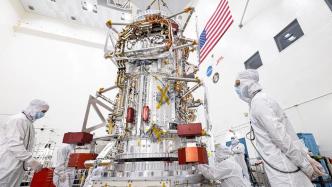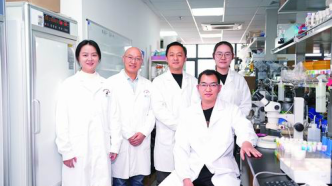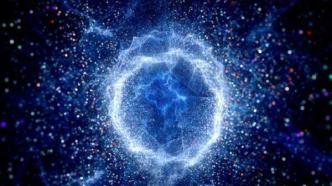
At 3 o'clock in the morning on November 18th, Beijing time, "Science" magazine issued an "editorial retraction" statement, withdrawing a paper on "angel particles". This is another majorana fermion research that has been withdrawn by a top international journal after "Nature" withdrew a research paper in this field in March 2021.
The retracted paper was published on July 21, 2017. The paper shows that the researchers observed chiral Majorana fermions (or "angel particles") in experiments. There are 4 corresponding authors of the paper, namely He Qinglin, Kou Xufeng, Zhang Shoucheng, and Wang Kanglong, all of whom are Chinese scientists.
The retraction statement mentioned: "After the publication of the paper, readers who failed to reproduce the research results requested the author to provide the original data file. Subsequently, the source of the original data was questioned; moreover, the analysis of the original data and the published data revealed that Serious irregularities and discrepancies were identified. These issues caused the editors of Science to lose confidence in the conclusions of the paper, so we issued an editorial retraction."
In this regard, Wang Kanglong, the main corresponding author of the paper and a professor at the University of California, Los Angeles, exclusively responded to the "China Science Daily", saying that the relevant statements in the retraction statement were "groundless".
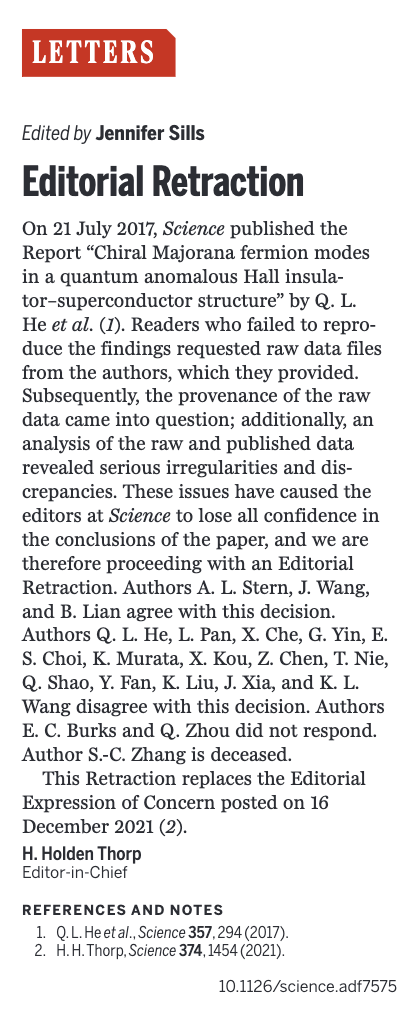
Science journal retraction statement. Source: SCIENCE
Editorial retraction: 14 authors disagree
Usually, there are two cases of paper retraction, one is the author's own retraction, and the other is the editorial department's retraction. This retraction belongs to the latter, and the retraction statement was signed by H. Holden Thorp, editor-in-chief of Science magazine.
According to the statement, 14 of the 20 authors of the paper disagreed with the withdrawal of the manuscript. Among the 4 corresponding authors, Zhang Shousheng died in December 2018, and He Qinglin, Kou Xufeng, and Wang Kanglong all disagreed with the withdrawal.
In his reply to the "Chinese Journal of Science", Wang Kanglong refuted the statement in the retraction statement.
He said, "All our data are real. Five years after the paper was published, we can still find the files of the experimental data originally used in the paper from the UC Irvine (University of California, Irvine) server, some of which are Repeat the experimental data. In addition, new researchers in our laboratory have also repeated the experimental results of the paper; other scientists have also repeated the experimental results using the samples we provided, showing the quantitative results in our 2017 paper. We maintain that our paper has scientific merit. We believe that Science's editorial decision is unwarranted and unjust."
Regarding the retraction, Matthew Wright, deputy director of the News Group of the American Association for the Advancement of Science, gave more information. He replied to the Chinese Journal of Science by email:
"This decision was reached by the editorial board of Science in consultation with a number of experts, all of whom signed non-disclosure agreements. After careful and exhaustive deliberation, the editors concluded that the authors had no Make a scientific and reasonable explanation for the non-compliance in the document.”
The sensation of 2017: Chinese scientists found "angel particles"
The withdrawn paper is titled "Chiral Majorana Fermion Modes in Quantum Anomalous Hall Insulator-Superconductor Structures", led by Wang Kanglong's research group at UCLA, Zhang Shoucheng's research group at Stanford University, Kou Xufeng from ShanghaiTech University The research group and other teams completed it together, with a total of 20 authors. After the paper was published, it caused a sensation in the global physics community.
Everything in the world has yin and yang, for example, electrons have positive and negative points. But in 1937, Italian physicist Ettore Majorana predicted the existence of a bizarre elementary particle that has no antiparticle, or that its antiparticle is itself. This particle is also named for its prophet.
However, scientists have been searching for 80 years, but have not been able to find this particle.
As early as 2008, Zhang Shousheng predicted the quantum anomalous Hall effect, which was confirmed by an experimental team led by Professor Xue Qikun of Tsinghua University in 2013. In the experiment, when the external magnetic field is adjusted, the abnormal quantum Hall effect film will present a "quantum platform", that is to say, the resistance in the quantum world can only jump steps in integer multiples.
This gave Zhang Shoucheng an inspiration: Majorana fermions have no antiparticles, which are equivalent to half of traditional particles. Traditional particles jump by integers, and Majorana fermions may jump by half integers—it will definitely show a Unique, "1/2 steps".
He also deduced that when the ordinary superconductor is placed on the anomalous quantum Hall effect film, the proximity effect enables it to realize chiral Majorana fermions, and a new quantum platform will be added in the corresponding experiment.
In follow-up experiments, the experimental team led by Wang Kanglong really saw the "1/2 step" and thought it was a strong proof of the existence of chiral Majorana fermions.
After the results caused a sensation in the world, Zhang Shoucheng compared chiral Majorana fermions to "angel particles". Its discovery is considered "or will open a new era." Zhang Shousheng himself is therefore considered to be "a Chinese who is close to winning the Nobel Prize".
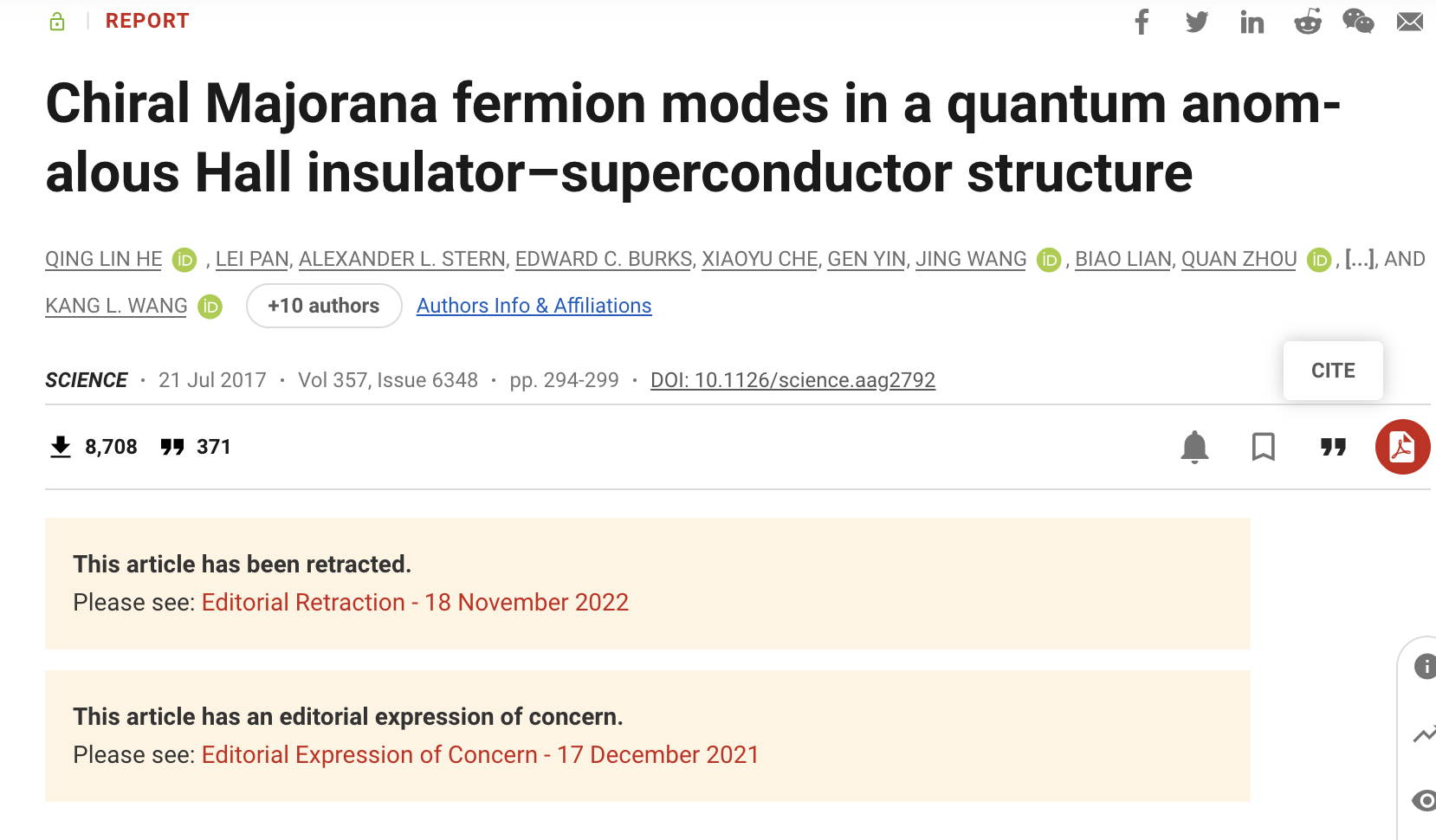
Source of the "Angel Particle" paper published in "Science": SCIENCE
The ensuing controversy: the "angel particle" signal may be caused by a short circuit
On the heels of the uproar came controversy over whether the experiment had actually observed the Majorana fermions. In the face of various doubts, the author disclosed the original data files.
However, on January 2, 2020, "Science" magazine published an "inversion" paper - "Lack of Evidence for Chiral Majorana Fermion Modes in Quantum Anomalous Hall-Superconductor Devices", and the experimental results showed that, "The step of 1/2" is not induced by chiral Majorana fermions, but because of "short circuit", "non-Majorana mechanisms can also produce similar signals".
The authors of this paper are Chang Cuizu and others from Pennsylvania State University in the United States. They took a year to test more than 30 samples, but none of them repeated the chiral Majorana fermion mode.
After the "reversal" paper was published, He Qinglin and Wang Kanglong publicly responded to the doubts: "Combining the results of the two teams of UCLA (University of California, Los Angeles) and Penn State (Penn State University), we can conclude that although The material system is very close in the basic physical picture, but due to the differences in many experimental details, the distribution of topological phases and its control parameters may be very different, and the two teams may in fact be exploring different parts of a huge phase diagram, rather than a result The rejection or denial of another outcome."
However, "Science" issued an "Editor's Concern" statement on December 17, 2021, reminding readers of the "concerns" of the paper: "After the paper was published, the authors provided the original data file in response to the failure to reproduce the research results. However, these data files did not clarify underlying issues, and the provenance of the data is now called into question. We draw readers' attention to these concerns while the authors' institutions investigate further."
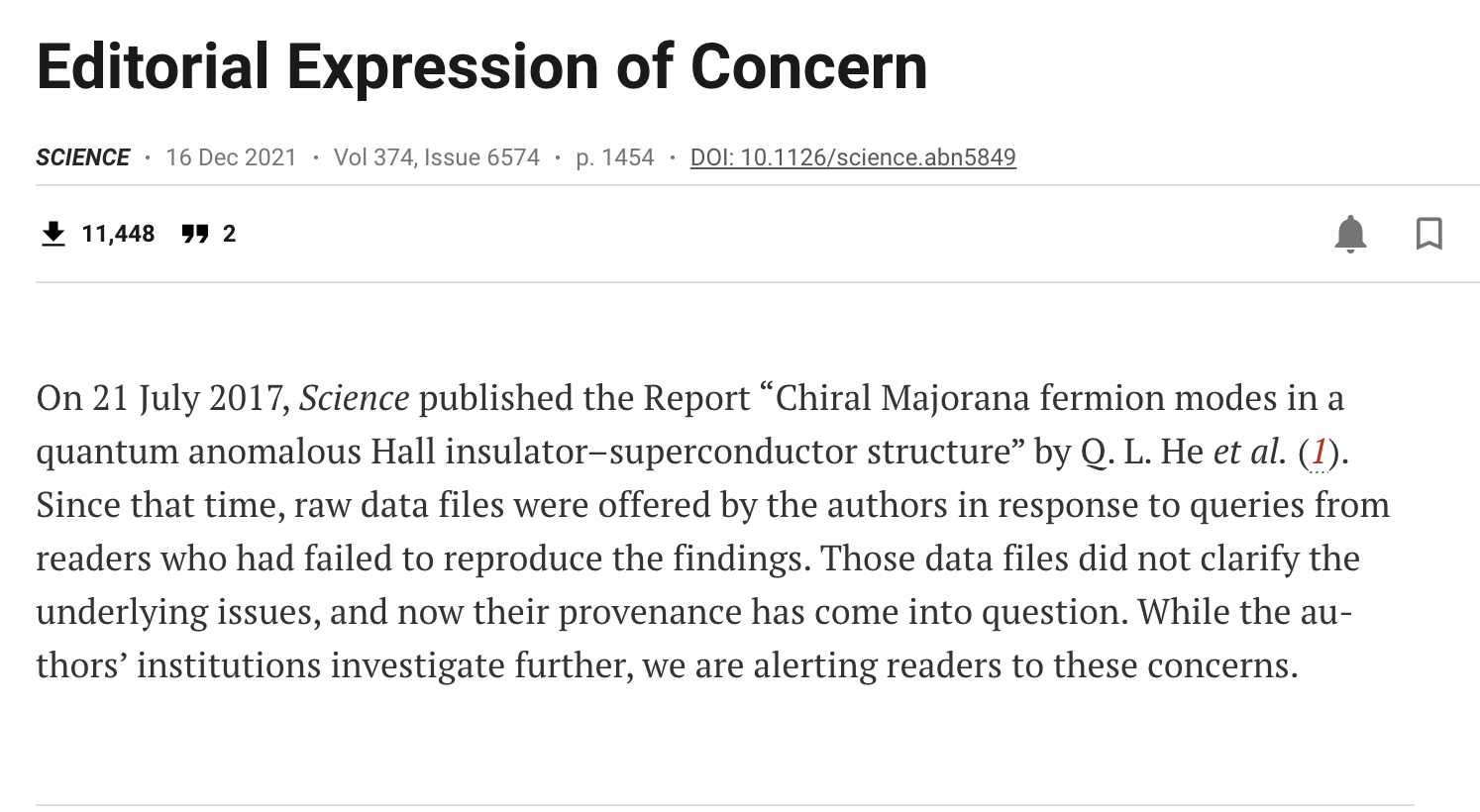
Source of "Editor's Concern" statement issued by "Science": SCIENCE
"Nature" and "Science" successively "retracted": 2 retractions + 1 "editor's attention"
This retraction is not the first time Majorana's fermion research has suffered from Waterloo. On March 8, 2021, Nature retracted a Majorana fermion paper.
The paper was published on March 28, 2018, entitled "Quantized Majorana Conductance", led by a team led by Leo Kouwenhoven, a professor of physics at Delft University of Technology in the Netherlands and employed by Microsoft. The paper shows that they observed evidence of Majorana fermions in semiconductor nanowires.
After the paper was published, it was also questioned. On April 29, 2020, "Nature" expressed "editorial concern" to the paper. The author stated that there were potential problems in the way it handled the raw data of this paper, and the editor reminded readers to "do not use the results of this study ".
Unlike the majority of authors who did not agree to the retraction of the manuscript in the "Science" retraction incident, the official retraction statement of "Nature" was written by the author. In their retraction statement, they acknowledged the mishandling of the data, noting that "the data for two figures in the paper were unnecessarily corrected for charge jumps, and the axes of one of the figures were mislabeled".
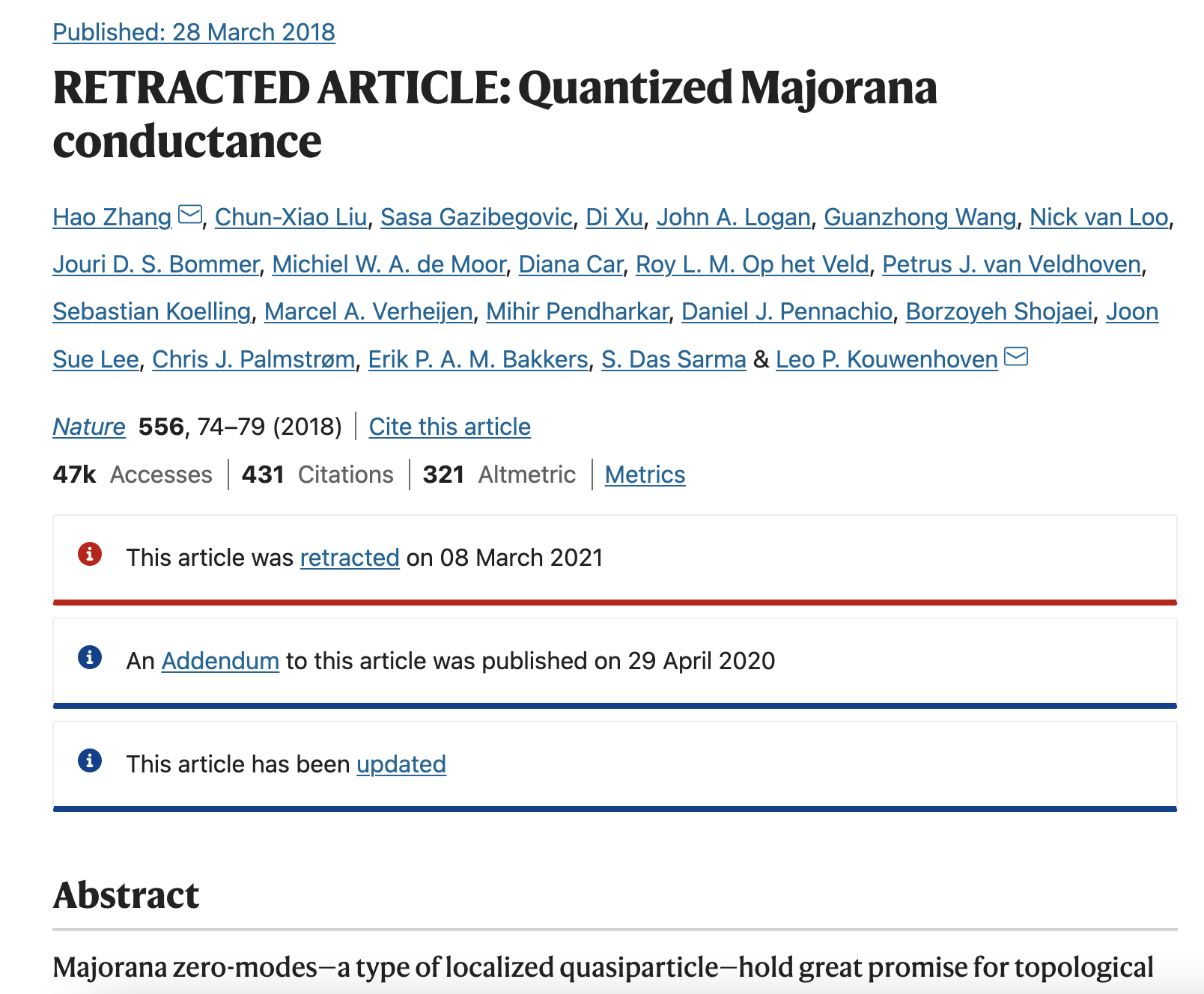
Source of papers related to Majorana fermions withdrawn by Nature: NATURE
In addition, in 2021, another Majorana fermion-related query occurred in the journal Science.
On July 30, 2021, Science published "Editor's Concern", reminding readers to pay attention to the article "Flux-induced topological superconductivity in full shell nanowires" published on March 27, 2020, because some readers found that "the tunneling spectroscopic data published in the original paper do not represent the full range of data relevant to this project". However, the paper has not yet been withdrawn.
The paper was completed in collaboration with researchers from the University of Copenhagen, the University of California, Santa Barbara and other institutions. The study claimed that in a semiconductor nanowire completely wrapped by a superconductor, a "relationship with the Majorana zero-energy mode" was found. Consistent evidence emerges".
Is there any hope of finding Majorana fermions?
Will the search for Majorana fermions cast a cloud over the barrage of retractions and "editorial attention"? "Chinese Journal of Science" interviewed two domestic experts in the field of condensed matter physics.
Dai Xi, Professor of Physics, Hong Kong University of Science and Technology:
In recent years, "Nature" and "Science" have published many reports on Majorana fermion research. Strictly speaking, all the studies are not "discovering Majorana fermions", but "seeing Majorana fermions". Signs of the existence of nanofermions". The repeated withdrawal of manuscripts is precisely because it is difficult to distinguish between true and false. The signs seen in the experiment may be caused by Majorana fermions, or may be caused by other factors.
On the other hand, the competition in the field of Majorana fermion research has always been fierce. Everyone wants to publish the data first, and the commercial hype models of star journals such as "Nature" and "Science" have intensified the impetuous atmosphere of competition. Therefore, the retraction incident also sounded the alarm for the physics community. It reminds everyone that although peer competition is fierce and the pace of modern science is very fast, the rigorous standards of scientific research have never dropped.
Of course, the retraction could cast a cloud over Majorana fermion research. The biggest negative impact should be that it will affect the funding support of related research topics, but squeezing out some academic bubbles is beneficial to the long-term development of the entire field. In the long run, the retraction of a paper is equivalent to pointing out and removing an erroneous message. This is not a bad thing, because the existence and misleading of erroneous information are the real dark clouds in the development of academia.
In my opinion, the Majorana fermion-related issues are still very important research topics, and we should not give up eating because of choking, and we should not question the scientific importance of the topic itself because of problems in a few articles.
In fact, the theoretical proposal proposed by Mr. Zhang Shoucheng about the possible generation of Majorana fermions in the quantum anomalous Hall system has never been questioned.
I am also full of confidence in the field of Majorana fermion research, because we are far from perfect in terms of material preparation and device design, and there is still a lot of room for improvement.
Ding Hong, Chair Professor of Tsung-Dao Li Institute of Shanghai Jiaotong University:
The Majorana fermion itself has great physical significance. If it can be confirmed experimentally, it should be a Nobel Prize-winning work.
However, real experimental evidence for Majorana fermions is hard to find. In fact, many properties of Majorana fermions are similar to other quasiparticles, and the phenomena observed in experiments are very similar, which can easily lead to "wrong information"; in addition, there are also difficulties in experiments, including experimental preparation, measurement etc., require extreme conditions, making it difficult to repeat the experiment. What's more, experiments are greatly affected by external environment and conditions.
For example, experiments with nanowires as materials. Nanowire is a material that is limited to less than 100 nanometers in the lateral direction. It is so thin that it must be operated under a super-high-power microscope. It is extremely difficult to prepare and measure. Currently, only a few research groups in the world are conducting research. Nanowires have their own advantages, and they are not completely unworkable.
The probability of error due to objective reasons is very high. This situation will also cause artificial luck, and there may be some "fake" phenomena. Of course, not all retractions are due to falsification.
Despite repeated retractions, the search for Majorana fermions is still important and must be done. The discovery of Majorana fermions is not only important in enriching the treasure house of human knowledge, but also in the hope of having practical effects on topological quantum computers.
Zero-energy quasiparticles similar to Majorana fermions may appear in solid materials, which are called "Majorana zero-energy modes". The weaving operation on such quasiparticles is an important way to realize fault-tolerant topological quantum computing.
The development of everything is a curve, and there will be troughs when there are peaks. I think that the Majorana fermions have passed the first peak period and are going up from the trough. For young people, this field is full of opportunities, and now is the best time to enter.
(Reporter Feng Lifei also contributed to this article, the original title is "Science Withdraws the "Angel Particle" Paper This Morning, Zhang Shoucheng is one of the corresponding authors")
references:
1. Chiral Majorana fermion modes in a quantum anomalous Hall insulator–superconductor structure, https://www.science.org/doi/10.1126/science.aag2792
2. Editorial Expression of Concern, https://www.science.org/doi/10.1126/science.abn5849
3. Editorial Retraction, https://www.science.org/doi/10.1126/science.adf7575
4. Absence of evidence for chiral Majorana modes in quantum anomalous Hall-superconductor devices, https://www.science.org/doi/10.1126/science.aax6361
5. RETRACTED ARTICLE: Quantized Majorana conductance, https://www.nature.com/articles/nature26142
6. Editorial Expression of Concern: Quantized Majorana conductance, https://www.nature.com/articles/s41586-020-2252-6
7. Retraction Note: Quantized Majorana conductance, https://www.nature.com/articles/s41586-021-03373-x
8. Flux-induced topological superconductivity in full-shell nanowires, https://www.science.org/doi/10.1126/science.aav3392
9. Editorial Expression of Concern, https://www.science.org/doi/10.1126/science.abl5286
10. Historic Breakthrough in Physics: Chinese Scientists Found "Angel Particles", People's Daily Online-International Channel, http://world.people.com.cn/n1/2017/0721/c1002-29419180.html
11. Deep condolences! Zhang Shoucheng, an outstanding alumnus of Fudan University, passed away, official website of Fudan University, https://jgb.fudan.edu.cn/6c/26/c20994a224294/page.htm
12.Science published the first paper with negative results: the disappearing "angel particle", Zhishe Academic Circle, January 3, 2020
13. Wang Kanglong, He Qinglin: Response to Whether "Angel Particles" Exist in Solids, Intellectuals, January 8, 2020
14. Inaccuracy or academic misconduct? The retraction of Majorana fermion research in Nature sparks controversy, Web of Science, April 15, 2021
